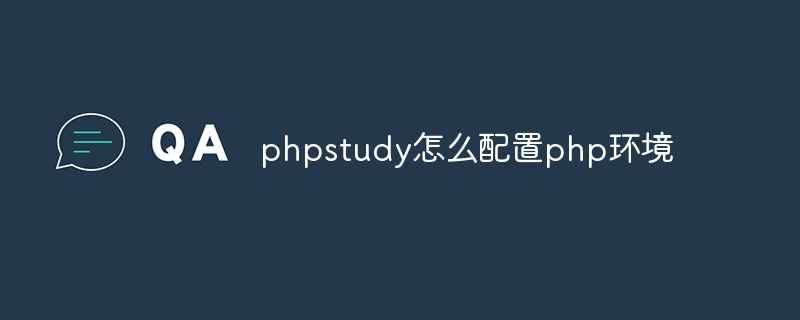How to configure php environment in phpstudy
Steps to configure the PHP environment to use PHP Study: Install PHP Study and create a PHP project. Configure PHP version and extensions. Configure the MySQL database (optional). Create a test file and visit the PHP information page to verify the correctness of the configuration.

How to configure the PHP environment to use PHP Study
1. Install PHP Study
- Download the PHP Study installer from the official website.
- Run the installer and select the installation path.
- Follow the prompts to complete the installation.
2. Create a PHP project
- In the main window of PHP Study, click the "Website" tab.
- Click the "Add Website" button and enter the project name and root directory.
- Click "OK" to create the project.
3. Configure PHP version
- Select the project in the project tree.
- Right click and select "Server Settings".
- Under the "PHP Version" tab, select the desired PHP version from the drop-down menu.
4. Configure PHP extensions
- Under the "PHP Extensions" tab, check the extensions you want to enable.
- PHP Study will automatically install and enable the selected extensions.
5. Configure MySQL
- If you need to use MySQL, please make sure you have installed the MySQL server.
- In the main window of PHP Study, click the Database tab.
- Click the "Add Database" button and enter the database name, username and password.
- Click "OK" to create the database.
6. Test the PHP project
- Create a file named "info.php" in the project root directory.
- Add the following code to the file:
<?php phpinfo();
- Enter the project's URL into your browser (for example, http://localhost/project-name/info.php ).
- You should see the configuration information for PHP, indicating that the PHP environment is configured correctly.
Tip:
- You can start a project by right-clicking it in the main window of PHP Study and selecting Start.
- You can further configure project settings by right-clicking on the project and selecting "Settings".
The above is the detailed content of How to configure php environment in phpstudy. For more information, please follow other related articles on the PHP Chinese website!

Hot AI Tools

Undresser.AI Undress
AI-powered app for creating realistic nude photos

AI Clothes Remover
Online AI tool for removing clothes from photos.

Undress AI Tool
Undress images for free

Clothoff.io
AI clothes remover

AI Hentai Generator
Generate AI Hentai for free.

Hot Article

Hot Tools

Notepad++7.3.1
Easy-to-use and free code editor

SublimeText3 Chinese version
Chinese version, very easy to use

Zend Studio 13.0.1
Powerful PHP integrated development environment

Dreamweaver CS6
Visual web development tools

SublimeText3 Mac version
God-level code editing software (SublimeText3)

Hot Topics
 How do I configure Xdebug in phpStudy to work with my IDE (PhpStorm, VS Code, etc.)?
Mar 13, 2025 pm 12:38 PM
How do I configure Xdebug in phpStudy to work with my IDE (PhpStorm, VS Code, etc.)?
Mar 13, 2025 pm 12:38 PM
This article guides configuring Xdebug within phpStudy for use with IDEs like PhpStorm & VS Code. It details Xdebug installation, php.ini configuration (including xdebug.mode, xdebug.client_host, xdebug.client_port), IDE setup, and troubleshooti
 What to do if phpstudy stops after starting
Mar 05, 2025 am 11:10 AM
What to do if phpstudy stops after starting
Mar 05, 2025 am 11:10 AM
This article addresses why phpStudy fails to start or unexpectedly stops. Common causes include port conflicts, insufficient system resources, corrupted installations, antivirus interference, and software conflicts. Troubleshooting involves checking
 How to create Phpstudy Xiaopi
Mar 05, 2025 am 11:08 AM
How to create Phpstudy Xiaopi
Mar 05, 2025 am 11:08 AM
This article guides users on creating and managing websites using PhpStudy. It details creating new website directories, configuring virtual hosts for multiple projects, and setting up the PHP environment. The main focus is streamlining website dev
 How to connect to phpstudy in navicat
Mar 05, 2025 am 11:07 AM
How to connect to phpstudy in navicat
Mar 05, 2025 am 11:07 AM
This article guides connecting Navicat to phpStudy's MySQL database. It details obtaining necessary connection parameters (hostname, port, username, password, database name) from phpStudy's configuration, troubleshooting common connection issues (i
 How do I configure phpStudy to handle HTTP authentication in a secure manner?
Mar 17, 2025 pm 06:02 PM
How do I configure phpStudy to handle HTTP authentication in a secure manner?
Mar 17, 2025 pm 06:02 PM
The article discusses configuring phpStudy for secure HTTP authentication, detailing steps like enabling HTTPS, setting up .htaccess and .htpasswd files, and best practices for security.Main issue: Ensuring secure HTTP authentication in phpStudy thro
 How to solve the problem of phpstudy's apache turning red
Mar 05, 2025 am 11:06 AM
How to solve the problem of phpstudy's apache turning red
Mar 05, 2025 am 11:06 AM
phpStudy's red Apache status signifies a server failure. Common causes include port conflicts, configuration errors, permission issues, and insufficient system resources. Troubleshooting involves restarting Apache, checking error logs, verifying con
 phpstudy cannot start the database. What should I do if phpstudy cannot start the database?
Mar 05, 2025 am 11:09 AM
phpstudy cannot start the database. What should I do if phpstudy cannot start the database?
Mar 05, 2025 am 11:09 AM
phpStudy database startup failures are a common issue with multiple potential causes. This article details troubleshooting steps, focusing on insufficient resources, port conflicts, misconfigured MySQL settings, corrupted files, and phpStudy install
 How do I set up a custom session handler in phpStudy?
Mar 17, 2025 pm 06:07 PM
How do I set up a custom session handler in phpStudy?
Mar 17, 2025 pm 06:07 PM
Article discusses setting up custom session handlers in phpStudy, including creation, registration, and configuration for performance improvement and troubleshooting.






